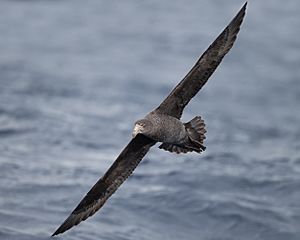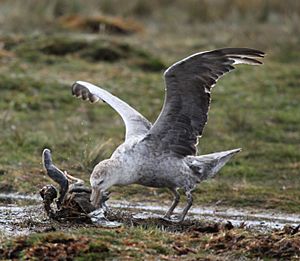Northern giant petrel facts for kids
Quick facts for kids Northern giant petrel |
|
|---|---|
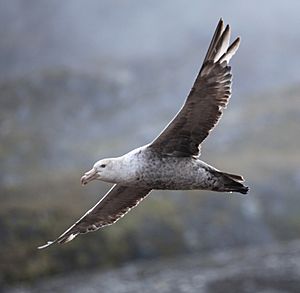 |
|
| Flying over Godthul, South Georgia, British Overseas Territories | |
| Conservation status | |
| Scientific classification | |
| Genus: |
Macronectes
|
| Species: |
halli
|
 |
|
| Global map of eBird reports Year-Round Range Summer Range Winter Range | |
The northern giant petrel (Macronectes halli), also called Hall's giant petrel, is a very large seabird that hunts for food in the southern oceans. It looks a lot like the southern giant petrel (Macronectes giganteus), but usually lives a bit further north.
Contents
About the Northern Giant Petrel
The two types of giant petrels, northern and southern, belong to a group of birds called Macronectes. These birds are part of a larger group called Procellariiformes, which are known as "tube-nosed seabirds" or "petrels."
All tube-nosed birds have special nostrils that look like tubes on top of their bill. Petrels, specifically, have these tubes joined together. Their bills are made of several strong, bony plates, and one of these plates forms a hooked tip on their upper bill.
These birds can also make a special "stomach oil." It's a high-energy liquid stored in their stomach. They can spray this oil out of their mouths to defend themselves from predators. It's also a super nutritious food source for their chicks and helps the adult birds have enough energy for their long flights.
Another cool thing about them is a special salt gland above their nose. This gland helps them get rid of extra salt from their bodies, which is important because they drink a lot of seawater. It lets out a salty liquid from their nostrils.
What's in a Name?
The name Macronectes comes from ancient Greek words. Makros means "long" or "large," and nēktēs means "swimmer." So, it means "large swimmer."
The name "petrel" comes from a story in the Bible about Saint Peter walking on water. This refers to how these birds seem to run or "walk" on the water's surface when they are taking off into flight.
What Does a Northern Giant Petrel Look Like?
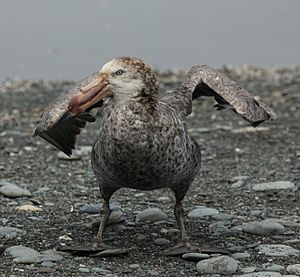
Northern giant petrels are usually about 90 centimeters (35 inches) long. Their wings can spread out very wide, from 150 to 210 centimeters (59 to 83 inches)! They are about the same size as their southern relatives.
The biggest northern giant petrels live in the South Georgia Islands. Males there can weigh around 4.9 kilograms (10.8 pounds), and females about 3.72 kilograms (8.2 pounds). The smallest ones are found on the Chatham Islands, where males weigh about 3.66 kilograms (8.1 pounds) and females about 2.83 kilograms (6.2 pounds). Overall, these birds can weigh anywhere from 2.5 to 5.8 kilograms (5.5 to 12.8 pounds).
Their feathers are grey-brown, but their forehead, sides of their face, and chin are lighter in color. Their bill is about 90 to 110 millimeters (3.5 to 4.3 inches) long. It's usually pinkish-yellow with a brown tip. Their eyes are grey.
Young northern giant petrels are completely dark brown. As they get older, their feathers become lighter. You can tell them apart from the southern giant petrel by the color of their bill tip: the northern species has a brown tip, while the southern species has a green tip.
Behavior and Life Cycle
What Do Northern Giant Petrels Eat?
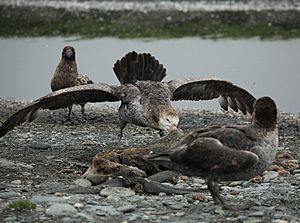
Northern giant petrels mostly eat carrion, which means dead animals like penguins and pinnipeds (seals). They also eat fish, krill, and squid. They often follow fishing boats and cruise ships, eating any leftover fish or waste that gets thrown overboard.
During the time they are raising their chicks, male petrels tend to eat more carrion, while females go out to sea to find food. These birds can be very bold and will even hunt and kill other seabirds, especially young penguins, sick or injured adult penguins, and the chicks of other birds like albatrosses.
Northern giant petrels look for food in similar places as southern giant petrels. However, they do it at different times because northern giant petrels start their breeding season earlier. This helps them avoid competing too much for food. Also, female petrels often travel further out to sea than males, which helps reduce competition between males and females of the same species.
Reproduction and Breeding
Northern giant petrels usually start having chicks when they are about ten years old. They build their nests in large groups called colonies on islands. They often share these nesting areas with southern giant petrels. Interestingly, northern giant petrels start their breeding season about six weeks earlier than their southern relatives.
Where Do Northern Giant Petrels Live?
Macronectes halli is a pelagic bird, meaning it spends most of its life out at sea. You can find them all over the Southern Ocean, especially north of the Antarctic Convergence Zone. They also live near the coasts of Chile, Argentina, South Africa, New Zealand, and parts of Australia.
More than 4,500 pairs of northern giant petrels nest on islands in the South Georgia group. They also nest on other islands like the Chatham Islands, Kerguelen Islands, Crozet Islands, and Macquarie Island. Their total living area is huge, covering about 82.6 million square kilometers (31.9 million square miles)!
Protecting Northern Giant Petrels
| Location | Number of Pairs | Year | Trend |
|---|---|---|---|
| South Georgia | 4,500 pairs | 2005 | Increasing 30% every 20 years |
| Forty-Fours | 2,000 pairs | 2000 | |
| Middle Sister | 80–100 pairs | 2000 | |
| Kerguelen Islands | 1,450–1,800 pairs | 1989 | |
| Crozet Islands | 1,300 pairs | 1989 | Decreasing |
| Macquarie Island | 1,300 pairs | Stable or increasing | |
| Prince Edward Islands | 650 pairs | Increasing | |
| Antipodes Island | 230 pairs | 2003 | |
| Campbell Island | 230 pairs | 2000 | |
| Auckland Islands | 50 pairs | 2000 | |
| Total | 17,000–21,000 | 2001 | Increasing 34% every 10 years |
In 2001, experts estimated there were between 17,000 and 21,000 adult northern giant petrels. This number has actually been growing over the last 20 years, even though it was once expected to go down. Because of this good news, the IUCN changed their conservation status from "Near Threatened" to "Least Concern." This means they are not currently at high risk of extinction.
Recent studies show that most places where these birds live are seeing their numbers increase, except for the Crozet Islands. This increase might be because there's more fish waste from boats for them to eat, better rules for longline fishing (which can accidentally catch birds), and more dead fur seals for them to scavenge.
Currently, the northern giant petrel is protected under international agreements like CMS Appendix II and ACAP Annex 1. Future plans include continuing to count the birds, studying where they travel, and working to reduce the number of birds accidentally caught by fishing boats.
See also
 In Spanish: Petrel gigante subantártico para niños
In Spanish: Petrel gigante subantártico para niños



